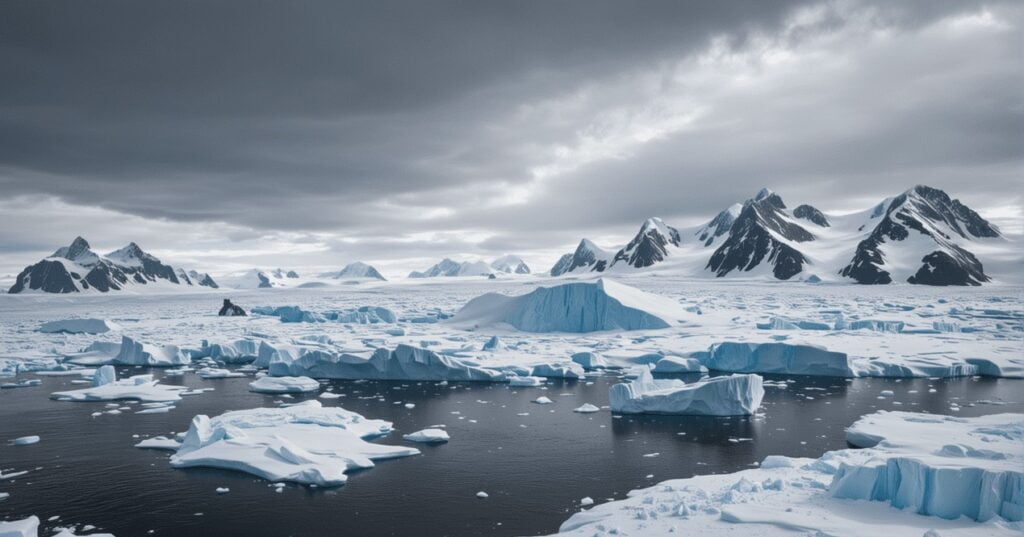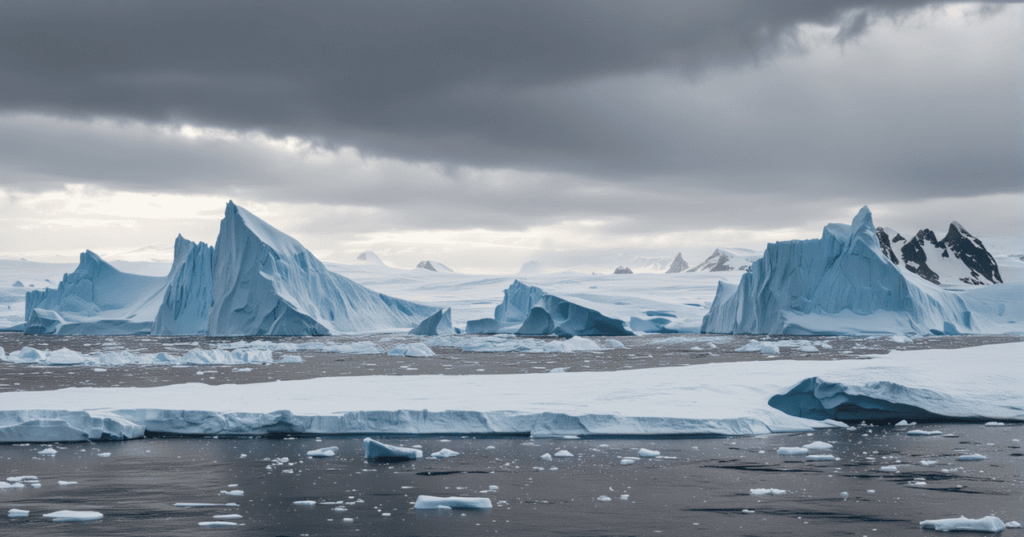Contents
Enter Antarctica’s icy wonderland and get ready to be astounded by the extreme weather conditions
This barren continent is home to some startling secrets that make it one of the harshest places on Earth, with its extreme weather conditions, from howling winds to bone-chilling temperatures. Scientists have been delving into the secrets of Antarctica’s climatic phenomena, fascinated by what lies beneath the continent’s glacial surface. They have found that a number of distinctive elements, such as its location on the planet, the Antarctic Circumpolar Current, and the existence of the polar ice cap, are responsible for its extreme weather.
As you venture into the fascinating continent of Antarctica, get ready to be amazed. Get ready for the exceptional weather that makes this frozen paradise unique.
Antarctica is a tribute to the amazing power of nature, with its bone-chilling temperatures and fierce winds whipping across the frozen terrain. As scientists continue to explore the atmospheric mysteries of this far-off continent, uncover the mysterious truths that lie beneath the surface. They reveal the incredible forces at work, illuminating how its unique location, the Antarctic Circumpolar Current, and the polar ice cover combine to create an unmatched environment.
Factors contributing to Antarctica’s extreme weather
As the world’s coldest, driest, and windiest continent, Antarctica sees some of the most extreme weather patterns ever recorded by humankind. This far-flung region of the earth has a severe climate due to a confluence of unusual variables. Antarctica’s unique location at the southernmost point of the world is one of the main causes of its harsh weather. This barren island, which lies nearly totally inside the Antarctic Circle, is subject to the full power of the planet’s icy polar air masses.
The weather in Antarctica is also greatly influenced by the vast oceanic circulation known as the Antarctic Circumpolar circulation, which circles the continent. Large volumes of frigid water are transported around Antarctica by this strong circulation separating it from the warmer currents present at lower latitudes in an efficient manner. Because of this, the nearby water serves as a natural barrier, preventing any appreciable cooling of the temperature and aggravating the already severe circumstances.
An other element contributing to the extreme weather in Antarctica is the existence of the polar ice cap. The majority of the solar radiation that reaches the continent is reflected back into space by the massive coating of ice covering it. The surface remains chilly due to the strong albedo effect, causing temperatures to remain below freezing. In addition, the ice cap, which covers the nearby waters, prevents heat from the ocean from escaping into space by acting as an insulator. The harsh weather that is typical of Antarctica is exacerbated by this insulation.
1) The polar vortex’s impact on Antarctica’s weather
In the domain of extreme weather in Antarctica, the polar vortex is a prominent factor. During the winter, a vast region of frigid, low-pressure air circles the South Pole counterclockwise, creating the polar vortex. The icy temperatures and powerful winds that blanket the continent are caused by this atmospheric phenomenon.
The Earth’s rotation, the Coriolis effect, and the temperature differential between the polar and mid-latitude areas combine to generate the polar vortex. The polar vortex intensifies during Antarctic winter low temperatures, generating a close-knit circulation of cold air masses. Antarctica has harsh weather because of its strong vortex that effectively traps the cold air over the continent.
Remember that the polar vortex is not exclusive to Antarctica. The Arctic and other polar regions have similar atmospheric properties. However, because of the continent’s remote location and lack of large land masses that could interfere with its circulation, the Antarctic polar vortex is frequently more noticeable and powerful. This makes Antarctica an important place to research the polar vortex’s dynamics and how they affect the world’s weather patterns.
2) The Southern Ocean’s effect on Antarctica’s climate
Antarctica is surrounded by the Southern Ocean, which has a significant impact on the climate of the continent. This enormous body of water functions as a buffer, controlling the temperature of the air and affecting the weather across the continent. The unique climate system created by the interaction of Antarctica’s frozen terrain with the Southern Ocean is one of the factors contributing to the region’s extreme weather events.
Antarctica is surrounded by strong, enduring westerly winds that are characteristic of the Southern Ocean. Due to the lack of any major land masses to obstruct them, these winds—known as the Roaring Forties, Furious Fifties, and Screaming Sixties—are able to amass substantial energy as they whip across the open ocean. Dense cloud cover and copious snowfall arise from these winds picking up moisture and becoming even colder as they approach the frozen continent.
The Southern Ocean’s existence affects the surrounding air masses’ temperature as well. Large volumes of solar heat energy are absorbed and stored by the ocean, which functions as a gigantic heat sink. The temperature and moisture content of the air masses that contact with Antarctica are changed as this stored heat is released into the atmosphere. Extreme temperature gradients that contribute to Antarctica’s extreme weather are produced by the interaction of modified air masses from the Southern Ocean with frigid air from the polar regions.

3) Comprehending Antarctica’s katabatic winds
The development of katabatic winds is one of the most remarkable weather phenomena in Antarctica. These strong downslope winds are to blame for some of the most dramatic weather phenomena that occur in this area and for much of the continent’s climate.
When cold, dense air from higher altitudes descends due to gravity, katabatic winds are produced. Strong, gusty winds are produced when the air descends because it gathers momentum and accelerates. When cold air from the center of the continent moves towards the coast along the ice sheet’s steep slopes, it creates katabatic winds in Antarctica. These winds, which have the potential to exceed 200 km/h (120 mph) and last for many days, can produce blizzard-like conditions and further lower temperatures.
The polar ice cap’s existence is directly related to the development of katabatic winds in Antarctica. Cold air is generated by the frozen landscape and builds up at higher altitudes. When the correct circumstances arise, like calm and clear skies, the trapped cold air mass starts to flow downward and gets stronger as it falls. The katabatic winds are essential for moving snow and ice throughout the continent in addition to contributing to the harsh weather that Antarctica experiences.
4) The impact that the ozone hole has on Antarctica’s weather
The ozone hole, a well-known atmospheric phenomena that hovers over Antarctica during the austral spring (September to November), exacerbates the continent’s already severe weather conditions. An area of the Earth’s stratosphere known as the “ozone hole” is where the concentration of ozone is noticeably reduced, allowing dangerous UV radiation to enter the atmosphere.
The primary cause of the ozone hole is the atmospheric discharge of compounds that deplete the ozone layer, such as chlorofluorocarbons (CFCs). These materials, which are primarily the result of human activity, build up in the polar areas where they react with sunlight to destroy ozone molecules. Changes in wind patterns and atmospheric dynamics are caused by the localized cooling effect of ozone depletion over Antarctica..
The ozone hole has a profound and wide-ranging impact on Antarctica’s weather. The temperature disparity between the polar area and mid-latitudes is impacted by the existence of ozone-depleted air in the stratosphere, which in turn impacts the polar vortex’s strength and location. Temperature, pressure, and moisture distribution over Antarctica can all fluctuate as a result of the ozone hole’s changing wind patterns, which can also interfere with the regular atmospheric circulation. The temperature and weather patterns of the continent may be significantly impacted by these changes, which could add to the extreme weather seen in this area.
5) Antarctica’s distinct weather patterns and phenomena
Antarctica is distinguished from all other places on Earth by its distinct weather patterns and events. An example of one of these phenomena is ice fog, or “diamond dust.” A sort of fog known as “ice fog” is made up of microscopic ice crystals that float in the air and produce an enthralling show of shimmering particles. Since the creation and persistence of ice crystals in the atmosphere are made possible by exceptionally low temperatures, polar regions—including Antarctica—are the places where this phenomena is most frequently seen.
The occurrence of mirages is another intriguing weather phenomenon in Antarctica. When light beams are refracted as a result of variations in air density and temperature, mirages happen. In Antarctica, “Fata Morgana,” a complex mirage that produces extended and distorted pictures of distant objects, is a common sort of mirage. These optical tricks can create the appearance of numerous suns or moons horizonally, towering cliffs, or even floating islands. Antarctica’s special atmospheric circumstances, such as temperature inversions, make it the perfect place for the production of these fascinating mirages.
Some of the world’s strongest winds are found in Antarctica. Antarctica is among the windiest areas on Earth because of the previously mentioned katabatic winds, which can reach hurricane-like speeds. These strong winds have a significant influence on the formation of the terrain in addition to causing harsh weather. The ferocious winds have shaped the glacial terrain for millions of years, leaving behind breathtaking features including wind-carved valleys, sastrugi, and ice dunes.
How meteorological conditions in Antarctica are studied and tracked by scientists
It is no easy task to research and observe the harsh weather in Antarctica. Owing to the continent’s isolation and harsh climate, researchers have created cutting-edge tools and techniques to gather information and comprehend its distinct ecosystem.
Observations from orbit are essential for tracking Antarctica’s weather. Sea ice extent, temperature, cloud cover, and other atmospheric characteristics can all be measured and observed with the help of satellites fitted with a variety of sensors and instruments. These data support research on the relationships between the Southern Ocean and atmosphere, weather patterns, and polar ice cap variations.
Weather stations are strategically positioned on the ground to collect data on temperature, humidity, wind speed, and other meteorological variables in real time throughout Antarctica. For the purpose of climate modeling, weather forecasting, and comprehending the long-term patterns and dynamics of Antarctica’s weather systems, these data offer vital information.
Scientists use specialist equipment, including radiosondes and dropsondes, in addition to weather stations to gather data on the atmosphere. Little weather balloons called radiosondes are fitted with sensors that allow them to detect pressure, temperature, and humidity as they rise through the atmosphere. Conversely, dropsondes are launched from airplanes and offer precise vertical profiles of the atmosphere.
In addition to these measurements from satellites and the ground, scientists also carry out fieldwork in Antarctica and set up independent weather stations. These stations can continuously monitor the weather in isolated and inaccessible regions since they are outfitted with a variety of instruments and sensors.

The effects of Antarctica’s extreme weather on ecosystems and fauna
The species and ecosystems of Antarctica are significantly impacted by the harsh weather conditions there. This hostile environment has forced life to adapt in order to endure the constant cold, strong winds, and scarcity of supplies.
Numerous well-known Antarctic animals, including albatrosses, seals, and penguins, have evolved special behavioral and physiological adaptations to withstand the harsh environment. These animals maintain body temperature and prevent frostbite through the use of specialized blood circulation systems, which are supported by thick coats of blubber and insulating feathers. Certain species, such as the emperor penguin, snuggle tightly to retain body heat and alternately stand on the outside to protect their partners from the chilly air.
The distribution and abundance of marine life in the nearby Southern Ocean are similarly impacted by the intense weather. Nutrient-rich waters rise to the top in upwelling zones, which are created by strong winds and ocean currents. Krill, the base of the Antarctic food chain, are among the many marine species that thrive in these nutrient-rich waters. Weather-related changes, including variations in the strength of the wind or the temperature of the ocean, can have a domino effect on the ecosystem as a whole, affecting marine species’ ability to reproduce, their eating habits, and their general health.
Preserving this special and delicate ecosystem requires an understanding of how Antarctica’s harsh weather affects ecosystems and species. Studying Antarctica’s weather patterns and their influence on the fragile balance of life becomes ever more important as climate change continues to affect the planet.
The significance of researching Antarctica’s weather for understanding climate change
The harsh weather of Antarctica provides insight into the intricately linked mechanisms that regulate the climate of our world. Scientists are learning important lessons about the mechanisms behind weather patterns, atmospheric dynamics, and the effects of climate change by revealing the secrets concealed beneath the frozen environment.
The study of Antarctic weather has broad ramifications for our comprehension of global climate systems, making it more than merely an academic endeavor. Antarctica’s harsh climate and distinct natural features give scientists vital information for climate models, enabling them to improve their forecasts and evaluate the possible effects of climate change.
It is critical to track and understand Antarctica’s weather patterns as we continue to see the effects of a changing climate. By doing this, we will be able to gain a deeper understanding of the complex web of interactions that control the climate system on our planet, which will ultimately enable us to make wise decisions about how to alleviate the effects of global warming and adapt to its challenges.
It is a scientific initiative as well as a monument to humanity’s insatiable curiosity and resolve to comprehend and preserve the natural treasures of our planet to unlock the mysterious secrets of Antarctica’s harsh weather. Enter Antarctica’s freezing wilderness and discover the unexpected mysteries hidden beneath its extreme weather.

